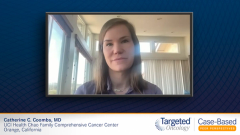
CLL: Prognostic Factors and Treatment Considerations
An expert on chronic lymphocytic leukemia discusses disease progression and prognostic factors that influence treatment decisions.
Episodes in this series

Case: A 70-Year-Old Man with R/R Chronic Lymphocytic Leukemia (CLL)
- Patient AL is a 70 y/o man.
- PMH: T2DM and Hypertension (both well controlled with medication)
- SMH: Does not smoke or drink alcohol.
Clinical Presentation:
- In July 2022, AL was diagnosed with CLL and had been previously treated with venetoclax plus obinutuzumab upon initial diagnosis. Less than 6 months later, AL presented to his oncologist reporting an unresolved fever and increased fatigue.
Clinical Workup and Molecular Testing:
- Laboratory Findings:
- WBC: 120,000
- Hgb, 9.1 g/dL
- Platelets, 92 x 109/L
- Molecular Testing:
- Elevated serum beta-2-microglobulin
- Flow cytometry, CD5+, CD19+, CD23+
- IGHV/TP53 mutational status: unmutated
- FISH detect del(17p)
- ECOG PS 1
Disease Relapse and Treatment(s):
- Further disease progression was documented, and a joint decision was made to initiate AL on venetoclax plus rituximab.
- Venetoclax Dosing Ramp-Up Schedule
- Starting dose of 20 mg PO QD x 7 days, then weekly ramp up to 50 mg, 100 mg, 200 mg, and 400 mg PO daily. The recommended daily dose (400 mg) continues from week 5 and beyond for 24 months.
- Rituximab 375 mg/m2 on C1D1 (28-day cycle), then 500 mg/m2 on Day 1 for 5 cycles (completing after month 6).
- Venetoclax Dosing Ramp-Up Schedule
Transcript:
Catherine C. Coombs, MD: How do I define disease progression? Patients with CLL [chronic lymphocytic leukemia] progress when there’s evidence of recurrent disease, which could be something as benign as a mildly elevated lymphocyte count after a patient’s lymphocyte count had normalized following therapy. It could be reappearance of lymph nodes or an increase in lymph node size. Regarding this patient, he certainly has had disease progression, as evidenced by his drastically elevated white blood cell count. What I’d like to mention is that disease progression doesn’t always warrant repeat therapy. This case does because the patient also has cytopenias, which are highly likely related to the disease given that these are also occurring in the setting of a high white [blood cell] count. He also has thrombocytopenia, so it’s less likely an isolated autoimmune process. My question always is…is the patient having evidence of progression, [and] is there also an indication for therapy? Which, in this case, there certainly is.
Regarding factors that I consider when initiating therapy, I continue to use the iwCLL [International Workshop on Chronic Lymphocytic Leukemia] criteria. However, when someone relapses, I have a slightly lower threshold because the use of therapy in the relapse setting is somewhat inevitable. But it can be very slow. I may observe the patient for a bit if they’re on the borderline of meeting an indication for therapy, but once they’re approaching these indications or having any sort of B symptoms, and I’ve excluded other possible causes such as infection, then I would proceed with therapy.
The factors that I consider in selecting a therapy are: What therapy had they received previously, what was their response to it, and how did they tolerate it? For our patient case, he received venetoclax, but he had a pretty poor response to it, so that lowers my enthusiasm for venetoclax re-treatment, though it is an option. Given that he had a very short response to the venetoclax, this is why I would [consider] switching classes or mechanism of action to a BTK [Bruton tyrosine kinase] inhibitor class. The other thing I would think of is, did the patient have any [adverse] effects?
If this patient tolerated venetoclax very well and had a longer response, I would be very enthusiastic about [venetoclax] re-treatment. If he had some sort of [adverse] effects [to] venetoclax, even with a long response, I might consider using something else to minimize re-exposing him to a potential [adverse] effect. That being said, most patients tolerate venetoclax pretty well aside from cytopenias, which are generally well supported by growth factors. In addition to these clinical features, I also always repeat prognostic testing. In our index case, we didn’t know what the patient’s markers were prior to therapy, but we do know what they were when he relapsed, which is that he has a deletion 17p. Especially in the relapse setting, patients with del(17p) do not enjoy long progression-free survival periods when off therapy, so I tend to lean toward continuous therapies for these patients. And I always use novel therapies, given how poorly chemoimmunotherapy performs in this subset.
Transcript edited for clarity.








































